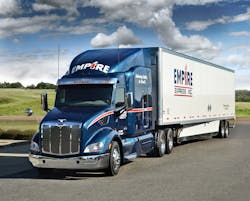COMPANY:
Empire Express, Memphis, TN
OPERATION:
Dry van carrier specializing in hauling hazardous chemicals and high-value, time-sensitive loads primarily in the eastern half of the U.S. and across Canada
Problem:
When Tim Gatlin joined Empire Express as president and CEO in 1989, it was almost exclusively a chemical hauler. Gatlin, though, moved quickly to expand and diversify. “Today, we have 195 tractors and about half of our loads are chemicals with about 30% hazmat,” says Gatlin. “Another 35% are just-in-time and only about 15% are general commodities.”
When you specialize in moving hazardous chemicals like cyanide and JIT freight, it’s not surprising that safety is a top priority. And, indeed, the fleet has an excellent long-term safety record and a reputation for reliable on-time service.
When the Federal Motor Carrier Safety Administration switched to the CSA safety reporting system in 2010, Empire Express was pleased to see that all of its scores being tracked by the system were strong. However, there was one exception—driver log violations were below the average achieved by the fleet’s peer group.
Gatlin believed that the problem was the fleet’s peer group consisted of large carriers that had all been long-time users of electronic logging devices. Although Empire Express had been using a wireless data and tracking system since 1991, its drivers still relied on paper logs. “We were seeing more alerts [for log violations], so we knew we had to deal with it by moving to electronic logs, too.”
Solution:
In January of 2012, Empire Express began testing e-log units from two suppliers and by July determined it would go with the Rand McNally TPC 7600, an onboard computer that offered wireless communications, navigation and other features as well as logging.
“After some training, we started installing the units ourselves in September and finished putting them in all of our trucks by May,” says Gatlin. “They were pretty easy to install.”
Transitioning drivers to the electronic system took a bit more effort. “We lost a few long-time drivers who were recruited by fleets still using paper logs, but most were happy, and I even had some tell me they wish we’d switched a long time ago,” Gatlin says. “I make it a practice to eat lunch every week with our new hires, and these younger drivers tell me they wouldn’t work for a fleet without electronic logs.”
While it meant less paperwork for the fleet’s drivers, perhaps the bigger impact was felt by the operations staff. “It put more planning responsibility on them to monitor and maximize drivers’ hours,” Gatlin said. Adding two planning modules from Manhattan Associates—Driver Load and Drop and Swap—that suggest three solutions in real-time for every load made the transition much easier, Gatlin explained. “It’s been a big help in scheduling loads and planning drivers.”
The Rand McNally OBCs have had the desired effect. Since switching to electronic logs, the fleet has only had five violations, and they were minor infractions for not laminating the paper instructions for roadside inspection officers conducting log checks. “Now we’ve laminated them, and we haven’t had another driver log violation in over two months,” says Gatlin.
If there’s been a downside, it’s an 8% drop in miles per driver. “If a driver is waiting at a truck stop to pick up a load, once he leaves to go to the customer location the clock starts running,” says Gatlin. “And if they have to wait for a load or if there’s any traffic delays, that really eats up time from the 11-hour [driving time] clock, and that hurts utilization.
“But given what we do, we have to have electronic logs,” he says. “And they’re working. Our CSA scores have really come down.”
On top of that, other functions and reporting capabilities of the OBCs offer the potential to regain some of that lost efficiency. Full dispatch with load information automatically downloaded to the units simplifies the drivers’ jobs, as does full turn-by-turn navigation, Gatlin points out. “And in the near future, we’ll start taking advantage of the auto-arrive alerts and geofencing features to streamline operations even more.”
About the Author
Jim Mele
Jim Mele is a former longtime editor-in-chief of FleetOwner. He joined the magazine in 1986 and served as chief editor from 1999 to 2017.
